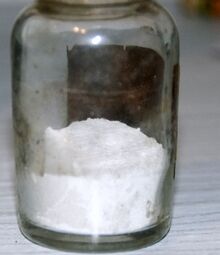Chemistry:Calcium arsenate

| |

| |
| Names | |
|---|---|
| IUPAC name
Calcium arsorate
| |
| Other names
Calcium orthoarsenate
Cucumber dust Tricalcium arsenate Tricalcium ortho-arsenate | |
| Identifiers | |
3D model (JSmol)
|
|
| ChemSpider | |
| EC Number |
|
| KEGG | |
PubChem CID
|
|
| RTECS number |
|
| UNII | |
| |
| |
| Properties | |
| Ca3(AsO4)2 | |
| Molar mass | 398.072 g/mol |
| Appearance | white powder |
| Odor | odorless |
| Density | 3.62 g/cm3, solid |
| Melting point | 1,455 °C (2,651 °F; 1,728 K) (decomposes) |
| 0.013 g/100 mL (25 °C)[1] | |
| Solubility in Organic solvents | insoluble |
| Solubility in acids | soluble |
| Hazards | |
| Main hazards | carcinogen[2] |
| NFPA 704 (fire diamond) | |
| Flash point | noncombustible [2] |
| Lethal dose or concentration (LD, LC): | |
LD50 (median dose)
|
20 mg/kg (rat, oral) 82 mg/kg (rat, oral) 74 mg/kg (mouse, oral) 50 mg/kg (rabbit, oral) 38 mg/kg (dog, oral)[3] |
| NIOSH (US health exposure limits): | |
PEL (Permissible)
|
TWA 0.010 mg/m3[2] |
REL (Recommended)
|
Ca C 0.002 mg/m3 [15-minute][2] |
IDLH (Immediate danger)
|
5 mg/m3 (as As)[2] |
Except where otherwise noted, data are given for materials in their standard state (at 25 °C [77 °F], 100 kPa). | |
| Infobox references | |
Calcium arsenate is the inorganic compound with the formula Ca3(AsO4)2. A colourless salt, it was originally used as a pesticide and as a germicide. It is highly soluble in water, in contrast to lead arsenate, which makes it more toxic. Two minerals are hydrates of calcium arsenate: rauenthalite Ca3(AsO4)2·10H2O and phaunouxite Ca3(AsO4)2·11H2O.[4] A related mineral is ferrarisite (Ca
5H
2(AsO
4)
4 · 9H2O.[5]
Preparation
Calcium arsenate is commonly prepared from disodium hydrogen arsenate and calcium chloride:
- 2 Na2H[AsO4] + 3 CaCl2 → 4 NaCl + Ca3[AsO4]2 + 2 HCl
In the 1920s, it was made in large vats by mixing calcium oxide and arsenic oxide.[6] In the United States, 1360 metric tons were produced in 1919, 4540 in 1920, and 7270 in 1922.[1] The composition of commercially available calcium arsenate varies from manufacturer to manufacturer. A typical composition is 80-85% of Ca3(AsO4)2 a basic arsenate probably with a composition of 4CaO.As2O5 together with calcium hydroxide and calcium carbonate.[citation needed]
Use as a herbicide
It was once a common herbicide and insecticide. 38,000,000 kilograms were reported to be produced in 1942 alone, mainly for protection of cotton crops. Its high toxicity led the development of DDT.[7]
Regulation
Calcium arsenate use is now banned in the UK, and its use is strictly regulated in the United States. It is currently the active ingredient in TURF-Cal manufactured by Mallinckrodt, it is one of the few herbicides – used mainly for the control of Poa annua and crabgrass- that hinders earthworm activity. Its label states that it will "reduce and inhibit earthworm activity and survival" and is only recommended against serious earthworm infestations in places such as golf course greens.[8]
Toxicity and regulation
Calcium arsenate is highly toxic, having both carcinogenic and systemic health effects.[9] The Occupational Safety and Health Administration has set a permissible exposure limit at 0.01 mg/m3 over an eight-hour time-weighted average, while the National Institute for Occupational Safety and Health recommends a limit five times less (0.002 mg/m3).[10]
It is classified as an extremely hazardous substance in the United States as defined in Section 302 of the U.S. Emergency Planning and Community Right-to-Know Act (42 U.S.C. 11002), and is subject to strict reporting requirements by facilities which produce, store, or use it in significant quantities.[11]
Other natural occurrences
Weilite is the monohydrogenated counterpart, Ca(HAsO4),[12] while švenekite – the dihydrogenated one, Ca(H2AsO4)2.[13] Hydrated analogues of weilite are haidingerite (monohydrate) and pharmacolite (dihydrate), with the latter name reflecting arsenic-related toxicity. Examples of more complex, hydrated Ca arsenates with some anions hydrogenated, are ferrarisite,[14] guérinite,[15] sainfeldite,[16] vladimirite,[17] and jeankempite.[18][19]
References
- ↑ 1.0 1.1 Tartar, H.V.; Wood, L; Hiner, E; A Basic Arsenate of Calcium. J. Am. Chem. Soc. 1924, vol. 46, 809-813.
- ↑ 2.0 2.1 2.2 2.3 2.4 NIOSH Pocket Guide to Chemical Hazards. "#0089". National Institute for Occupational Safety and Health (NIOSH). https://www.cdc.gov/niosh/npg/npgd0089.html.
- ↑ "Calcium arsenate (as As)". Immediately Dangerous to Life and Health Concentrations (IDLH). National Institute for Occupational Safety and Health (NIOSH). https://www.cdc.gov/niosh/idlh/7778441.html.
- ↑ Bari, Hubert; Catti, Michele; Ferraris, Giovanni; Ivaldi, Gabriella; Permingeat, François (1982). "Phaunouxite Ca3(AsO4)2•11H2O, a New Mineral Strictly Associated with Rauenthalite". Bulletin de Minéralogie 105 (4): 327–332. doi:10.3406/bulmi.1982.7624.
- ↑ Bari, Hubert; Permingeat, François; Pierrot, Roland; Walenta, Kurt (1980). "La ferrarisite Ca5H2(AsO4)4.9 H2O, une Nouvelle Espèce Minérale Dimorphe de la Guérinite". Bulletin de Minéralogie 103 (5): 533–540. doi:10.3406/bulmi.1980.7417.
- ↑ Smith, C.M.; Murray, C.W.; The Composition of Commercial Calcium Arsenate. Journal of Industrial and Engineering Chemistry; 1931, 23
- ↑ Robert L. Metcalf "Insect Control" in Ullmann’s Encyclopedia of Industrial Chemistry Wiley-VCH, Weinheim, 2002. doi:10.1002/14356007.a14_263
- ↑ Koval, C.F.. "Turf insect pest control guide: Urban Phytonarian Series". College of Agricultural and Life Sciences – University of Wisconsin-Madison. http://learningstore.uwex.edu/assets/pdfs/A2934.pdf.
- ↑ Tchounwou, P.B.; Patlolla, A.K.; Centeno, J.A.; Carcinogenic and Systematic Health Effects Associated with Arsenic – A Critical Review. Toxicologic Pathology; 2003, 31, 575-588
- ↑ "Calcium Arsenate". NIOSH Pocket Guide to Chemical Hazards. Centers for Disease Control and Prevention. 4 April 2011. https://www.cdc.gov/niosh/npg/npgd0089.html.
- ↑ 40 C.F.R.: Appendix A to Part 355—The List of Extremely Hazardous Substances and Their Threshold Planning Quantities (1 July 2008 ed.). Government Printing Office. http://edocket.access.gpo.gov/cfr_2008/julqtr/pdf/40cfr355AppA.pdf. Retrieved 29 October 2011.
- ↑ "Weilite". https://www.mindat.org/min-4259.html.
- ↑ "Švenekite". https://www.mindat.org/min-7076.html.
- ↑ "Ferrarisite". https://www.mindat.org/min-1485.html.
- ↑ "Guérinite". https://www.mindat.org/min-1767.html.
- ↑ "Sainfeldite". https://www.mindat.org/min-3503.html.
- ↑ "Vladimirite". https://www.mindat.org/min-4195.html.
- ↑ "Jeankempite". https://www.mindat.org/min-53206.html.
- ↑ "List of Minerals". 21 March 2011. https://www.ima-mineralogy.org/Minlist.htm.
 |


